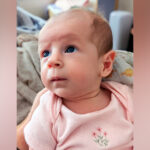Advice for moyamoya families from a mom who’s been there

About a year ago, our 4-year-old daughter, Kalea, started having headaches. After four months, we called our pediatrician because the headaches were far from normal for Kalea and had progressed enough to become worrisome. The pediatrician advised us to track her headaches, and we learned that they fluctuated in frequency but were increasing in intensity. That’s when our doctor referred us to the Headache Clinic at Boston Children’s Hospital.
Kalea passed her neurological exam at Boston Children’s, but knowing our child, we pushed for more tests to put our concerns at ease. Moyamoya, a rare condition that limits blood flow to the brain, runs in our family. (Our nephew Justin was diagnosed with moyamoya 12 years ago.) The chance that Kalea had moyamoya was only about 7 percent, but we asked for an MRI to have a better understanding of what was happening to her. Again, her doctors listened to our worries and ordered the test.
The results of the MRI and a cerebral angiogram confirmed that Kalea did have moyamoya. Three weeks after diagnosis, Dr. Edward Smith, a pediatric neurosurgeon at Boston Children’s and director of the Moyamoya Program, operated on Kalea. After a brief, albeit painful, vacation from the monkey bars, she’s recovered well physically from surgery. We’re working with her medical team to understand the effect the strokes she had before the surgery have had on her, but overall we’re confident she will improve. Now that we’re through diagnosis and surgery, I’d like to offer a little guidance to other families facing this condition.
Trust your intuition
This is the most important advice I could ever give a parent. No one knows your child like you do. The best doctors hear a parent’s worry and find an action that will bring the most reassurance. We’ve been blessed with a few key doctors, from our pediatrician to the specialists at Boston Children’s, who have listened to our concerns and acted on them in the best ways possible.

Trusting your instincts doesn’t end with surgery. We will always have to notice any changes in Kalea’s behavior and stick with what we know about her as an individual. Dr. Smith has been a huge support and has answered our concerns about things that just don’t seem right. The piece of mind he has brought us is invaluable. That’s what you want in any health care provider you see.
Consider surgery for moyamoya
I understand having surgery for moyamoya is a very personal decision and it’s made with the guidance of a medical team. Surgery is a huge undertaking, but when we weighed the pros and cons, surgery was short-term suffering for a long-term reward. Dr. Smith explained that for moyamoya patients, there’s a 66 to 90 percent chance of fatal stroke within five years of diagnosis without surgery. Doing nothing could have been a death sentence for our daughter. When Kalea’s angiogram showed very little blood flow in her brain, our decision was made. Kalea’s biggest complaint after surgery was that she wanted to run, jump, and swim. She proudly displays her “superpower scars,” the name her sister Alana lovingly gave her sutures, and knows the surgery is helping her headaches to get better.
Don’t go down a rabbit hole of information
Early on in our diagnosis, a friend cautioned us to not get lost in internet searches. She knew how easy it would be to consume every bit of information, but that not all of it would ease our minds. Of course, you want to learn everything you can about your child’s disease, but limit yourself. I read all of Dr. Smith’s articles and watched his videos. Any question we had, Dr. Smith answered. He called us the night our daughter was diagnosed and spent two hours explaining the surgery. The level of personal attention was overwhelmingly reassuring.

Surround yourself with a supportive community
We are truly blessed with a community of support from every direction. Without our friends and family this would have been an extremely lonely and scary life change. Our entire family was cared for and loved. While Kalea was in the hospital, our friends and family delivered meals, cleaned laundry, stocked groceries, and prayed for us. Our five other children were given a sense of normalcy through the chaos. Over the past few months, our pediatrician and medical community have pushed for proper testing of all our other children and other Boston Children’s personnel have made countless phone calls and emails following up with recovery. Don’t become an island or seclude yourself. Let others in to help and to hold your hand when the days get tough. Children can see fear so easily, and with others walking beside you, the road seems a lot less scary.
Learn more about the Moyamoya Program.
Related Posts :
-

A case for Kennedy — and for rapid genomic testing in every NICU
Kennedy was born in August 2025 after what her parents, John and Diana, describe as an uneventful pregnancy. Soon after delivery, ...
-

The journey to a treatment for hereditary spastic paraplegia
In 2016, Darius Ebrahimi-Fakhari, MD, PhD, then a neurology fellow at Boston Children’s Hospital, met two little girls with spasticity ...
-

The dopamine reset: Restoring what’s missing in AADC deficiency
In March 2023, a young girl came to Boston Children’s Hospital unable to hold up her head — one striking symptom ...
-

Thanks to Carter and his family, people are talking about spastic paraplegia
Nine-year-old Carter may be the most devoted — and popular — sports fan in his Connecticut town. “He loves all sports,” ...





